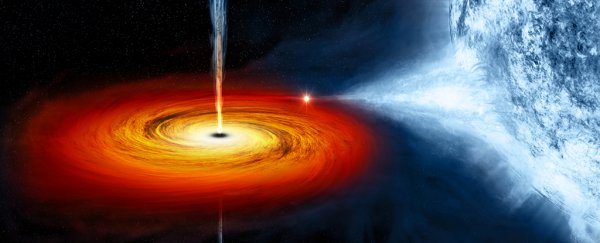Matter ejected from a spinning disc of doom surrounding a black hole a mere 15,000 light years away has produced some of the most energetic rays of light ever witnessed from an object of its kind.
The insanely powerful photons of gamma radiation were produced by a never-before-seen phenomenon surrounding a miniature quasar. The discovery could help us better understand what goes on deep in the chaotic heart of the Milky Way.
SS 433 is a smaller version of the kinds of maelstrom of death you'd find lurking at the core of most galaxies. It's also in our neighbourhood, more or less, making it relatively easy to study.
So an international team of astrophysicists has taken a closer look at its characteristics, finding that the energy of some of the photons emitted by its plasma are about as strong as light waves can get.
Not only is this a cool find in its own right, the team discovered a strange new source for these high energy light waves, which could tell us more about SS 433's beefier cousins.
Your average, run-of-the-mill quasar is a supersized black hole with a mass that dwarfs our own Sun, sucking in clouds of gas and dust.
If you imagine sticking an industrial sized drill into your curtains and watching the fun, you might get some idea of what this looks like. Only in this instance the particles in those whirling sheets of matter are dragged to velocities that can be measured as a good fraction of the speed of light.
That intense friction results in some serious heat, producing a plasma that is then channelled by strong magnetic fields into beams of protons and electrons that stretch far across the galaxy.
Measuring quasars in detail is a challenge thanks to the fact they aren't exactly close by.
The nearest to us is Markarian 231, made up of a pair of supermassive black holes revolving around each other in a galaxy nearly 600 million light years away.
Which is why SS 433 is so attractive.
The microquasar has been on the maps for roughly thirty years, so it isn't exactly a new find. It's actually a binary system made of a black hole with a mass of maybe several suns and a companion supergiant star.
Being a smaller version of a quasar doesn't mean it pulls its punches. The microquasar still emits two powerful jets some 130 light years in length, channelled by its awesome magnetic fields to reach velocities of just over 25 percent lightspeed.
Previous studies on SS 433 noted emissions of hard X-rays, but aside from a few tantalising signs, nothing of significance could be solidly confirmed in the stronger gamma ray region.
Now, several years of observations made using the High-Altitude Water Cherenkov Observatory Gamma-Ray Observatory (HAWC) have shown there are definitely more energetic photons being churned out by those giant beams of plasma.
"The HAWC Observatory is the most sensitive instrument for photons at these very high energies, and it did not begin collecting data until 2015," says HAWC science coordinator and physicist Petra Huentemeyer.
Based on its observations, physicists have determined that there are photons with energies of at least 25 teraelectronvolts (TeV) being emitted from the jets.
That's 25 trillion times more energy than the kind of light we can see, and up to ten times greater than any previous measurement of light from a microquasar.
The observations don't come close to breaking the big records. The highest of the high-energy photons zipping through space are measured in exaelectron volts, and that requires adding five more zeroes.
But TeV energy photons like these aren't exactly trivial, ranking as some of the most energetic light waves shooting over our heads.
"Gamma photons with energies of 25 TeV have to be produced by particles of even higher energies," says physicist Francisco Salesa Greus from Cracow's Institute of Nuclear Physics of the Polish Academy of Sciences.
"These could be protons, but then they would have to have enormous energies at a level of 250 TeV."
By comparing the HAWC results with other observations, the team ruled out protons as the source of this emission.
Instead, most of the gamma rays seemed to be generated by the far lighter electrons in the plasma jets smacking into microwaves echoing through space long after the Big Bang.
Such a mechanism has never been described before, offering a potentially useful new way to understand the dynamics of quasars inside galaxies like our own.
"SS 433 is an unusual star system and each year something new has come out about it," says co-author Segev BenZvi from the University of Rochester.
This is one little monster than seems to be punching well above its weight.
This research was published in Nature.
